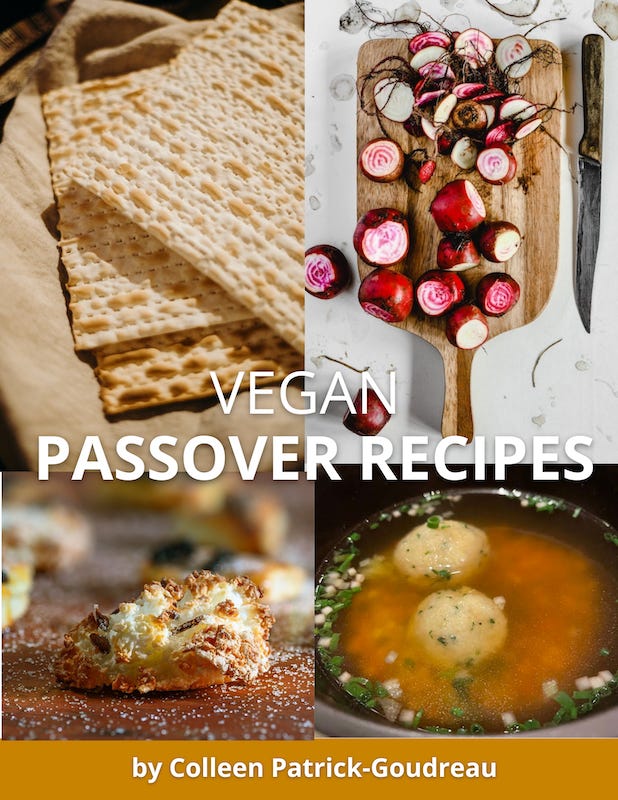How a Plant-Based Seder Celebrates the True Meaning of Passover
By centering our meals on foods that give life rather than take life, we align our behavior with the values we hold.
I hope you are enjoying all of the articles I’ve been writing. I would be so grateful if you would hit the ❤️ at the top or bottom of this post, share, and comment. It lets me know you’re there and helps other people find Compassion in Action! 🙏
In this piece on Passover, we look at how the foods we choose reflect the values we hold. By centering our meals on foods that give life rather than take life, we align our behavior with the values we hold. And what better way to celebrate the freedom from slavery than to use symbols that don’t merely convey compassion, freedom, and liberation but that actually are products of compassion, freedom, and liberation; i.e. plants?
I hope you’ve been enjoying my series The Food History of Easter and Passover—Through a Plant-Based Lens. So far, I’ve focused on Lent and Easter—exploring their symbols, stories, and rituals through the food traditions that have grown up around them, especially in the context of not eating animal products.
But now it’s time to turn to Passover (Pesach), which just began on sundown, Saturday, April 12 (2025) and ends at sundown on Sunday April 21 (for most Reform Jews and Jews in Israel) or Monday, April 21 (for those who observe the traditional 8-day practice in the diaspora).
The Meaning Behind the Seder Meal
Like Easter, Passover is a springtime holiday rooted in history, liberation, and renewal—and its food traditions are equally rich in symbolism and meaning. Passover, a Jewish festival that commemorates the exodus of Jews out of Egypt and thus from slavery to freedom, centers around the Seder meal.
Each food and beverage chosen represents an element of the narrative told in Exodus in the Bible and signifies the journey to freedom.
Before we get to the Seder plate, it’s worth noting that many traditional Passover dishes are already plant-based—or easily made so. From charoset to matzo ball soup (yes, without eggs!), from roasted vegetables to potato kugel, the Seder meal itself is full of meaningful, comforting foods that lend themselves beautifully to a compassionate table. (My Passover Recipe Bundle has 15 recipes for a Passover menu.)
While the Seder meal is a full-course dinner enjoyed with friends and family, the Seder plate itself is a distinct ritual element of the evening.
The word seder means “order,” referring to the structured retelling of the Israelites’ exodus from slavery in Egypt. The Seder plate holds six symbolic foods that help tell this story in a tangible, sensory way, but just as Easter eggs represent renewal and rebirth, these Seder foods stand for something else.
They convey the elements of the powerful message of Passover: that freedom is possible, that slavery can end, and that the future can be better than the past.
Six Symbols of Slavery, Freedom, and Hope
Although many plant foods are already traditionally part of the Seder meal, the Seder plate itself includes a few symbolic items that are typically animal-based. However, each of these can be thoughtfully replaced with plant-based versions—without sacrificing meaning or tradition.
Fruit (both dried and fresh), along with nuts and sweet spices are soaked in wine resulting in a flavorful dish called Charoset (or Haroset), representing the mortar that Jews worked with when they were enslaved by the Egyptians. (See Passover Menu for recipe.)
Bitter herbs represent the harshness of slavery. Ashkenazi Jews tend to use horseradish or the bitter-tasting heart of romaine lettuce; Sephardic Jews often use celery leaves, green onion, or parsley.
A vegetable, other than bitter herbs, is dipped in salt water to signify the slaves’ tears.
A boiled egg—a symbol of fertility and new life—is replaced at vegan Seders with roasted nuts, a flower, or a small white egg-sized eggplant. Same symbolic meaning. No suffering.
The only meat on the Seder plate tends to be the “shankbone” of a lamb or goat and is meant to represent the lamb who was offered for sacrifice. Jewish vegans use roasted beets, expressly allowed by the Talmud, or a sweet potato.
Symbols Matter—But Meaning Matters More
In being attached to the form / the symbols, we lose the true meaning of whatever it is we’re celebrating or honoring, especially when someone is harmed in the process. Conversely, when we focus on the meaning rather than on the symbol, we find that a plant-based menu more aptly reflects the significance of our traditional holidays.
By centering our meals on foods that give life rather than take life, we align our behavior with the values we hold. And what better way to celebrate the freedom from slavery than to use symbols that don’t merely convey compassion, freedom, and liberation but that actually are products of compassion, freedom, and liberation; i.e. plants?
Observing these spring holidays with the foods of the season also means creating menus around the season’s rich bounty: arugula, asparagus, basil, broccoli, cabbage, carrots, cauliflower, corn, fava beans, grapefruit, green onions, leeks, lemons, lettuce, limes, mint, nettles, new potatoes, parsnips, pea greens, peppers, radicchio, spinach, spring greens, and watercress.
With a little creativity and a lot of sensitivity, we will find that we can indeed adhere to traditions while honoring our values. We need not sacrifice one for the other.
And may it be so.
I also created a page where all of the articles and recipes in this series lives: The Food History of Easter and Passover—Through a Plant-Based Lens. Thanks for reading!
In this series:
The Meatless History of Lent: The tradition of abstaining from animal products during the 40 days before Easter
Homemade Soft Pretzels: Delicious and historical!
Tempura: The Plant-Based Origins of Japan's Favorite Fried Dish: What Lent, Language, and Latin Have to Do with Tempura
Carnival: A Meat-Free Tradition: the surprising origin of the word and its historic connection to meat
Celebrating Easter without Eggs: What better way to celebrate these ideals than by choosing objects that don’t just represent life and hope—but truly embody them?
The Sacred History of Pretzels: The Plant-Based Origins of Everyone's Favorite Snack


More Resources for You!
👉 Because the publisher took The Vegan Table (and Color Me Vegan) out of print, I am able to repurpose all of my recipes for which I own the copyright again. Please check out my Recipe E-Books and my library of On-Demand Cooking Classes for more recipes, including bundles for Easter and Passover!
👉 Travel with me! I host animal-friendly, luxury, all-inclusive vegan trips around the world, specifically curated to ensure high-quality, high-touch premium experiences. Check out our upcoming trips, and let me know if you have any questions.
👉 Work with me 1:1 – Get personalized guidance to build healthier habits, cultivate self-compassion, communicate with conviction, strengthen emotional resilience, or whatever you are looking for.
👉 Read A Year of Compassion – Daily inspiration to help you live with intention, kindness, and clarity
👉 Listen to Food for Thought – Inspiration for living compassionately, sustainably, and healthfully (18 years strong!)





